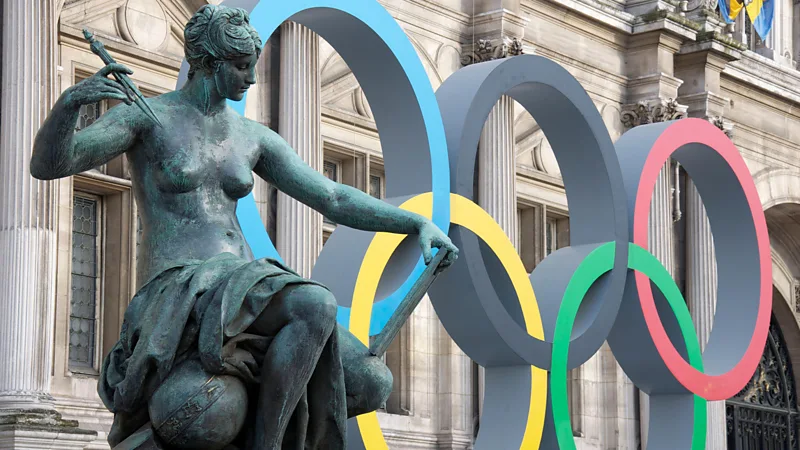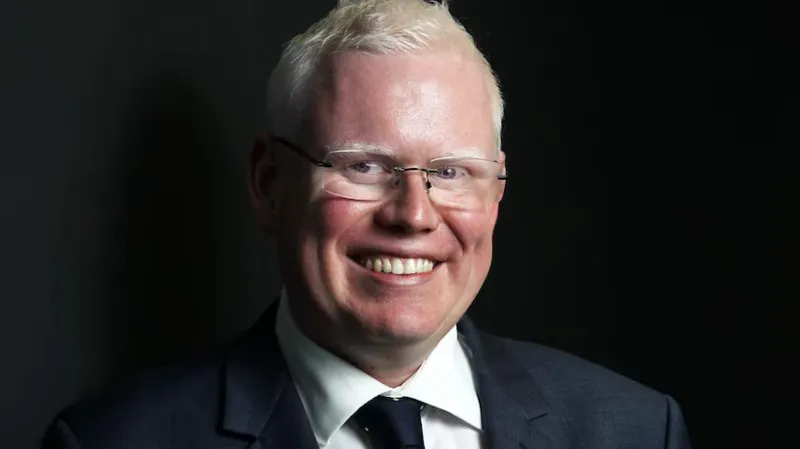When painting and sculpture were Olympic events
For nearly 1,000 years, the Greek games featured artistic competitions alongside athletic ones. Now, this ancient tradition is inspiring France's new Cultural Olympiad.

What does one wear to the Louvre Museum as Paris gears up for the 2024 Olympics? On a recent visit, my fashion instructions were specific: I should don my finest jogging gear. I had signed up for a unique running event called Courez au Louvre, which promised to turn France's most revered art institution into the world's most aesthetically pleasing gym.
This workout course mixing "inspiration" and "perspiration", as the Louvre's website promised, is just one small part of the so-called Cultural Olympiad: a sprawling series of more than 1,000 events touching on things like fashion, theatre, food and dance taking place across France until the end of September. The goal of these "other" summer games is to promote broad aspects of Gallic culture, but also to revive the little-known Olympic tradition of including artistic disciplines such as sculpture, architecture and literature that was common in ancient Greece, as well as the modern Games from 1912-1948 (including those in Paris 100 years ago).
Some events, like a recent "Waiter's Race", in which 200 aproned Parisian servers from Paris' top restaurants dashed 1.9km through the city's streets balancing a croissant, coffee and a glass of water on a tray; and an upcoming jazz-themed Olympic Ball evoking 1924 in the Musée d'Orsay, are one-offs. Others are recurring, including a string of sports-themed art exhibitions at museums and a Festival Enflammé – a series of maritime-themed gastronomic events hosted by the Culinary College of France. Quite a few, like outdoor photo exhibition Sport & Food, which includes "the favourite dishes of athletes" on display across the city from 26 July, are free to the public, while others are available for modest fees with online reservations, or by simply turning up.
And so, I dutifully showed up at 07:30 and entered the Louvre's iconic IM Pei glass-pyramid entrance. It was long before regular opening time, and sleepy guards and cleaners politely ignored the 60 sneaker-wearing art aficionados gathering at lockers by the foyer. After being divided into two colour-coded groups, I started jogging alongside an almost exclusively Parisian collection of early risers up the stairs and into empty galleries.
What followed was a gorgeous blur. First, we dashed into the marble-lined Marly Court to stretch on yoga mats beneath gleaming white statues of pagan gods. Next, a dancer named Queensy led us through energetic Afro-Caribbean hip rotations beneath enormous Assyrian human-headed winged lions. A fitness coach put us through lunges along a medieval wall. We did relay races up to a Sphinx. The climax came in the sun-filled Hall of the Caryatids lined with ancient Greek images: a disco dance workout to 1970s hits blasted on a boom box.
The emptiness of the Louvre was exhilarating – the museum normally receives 30,000 visitors a day – and reminded me of one of the most charming scenes in New Wave cinema, Jean-Luc Godard's Bande à Part (Band of Outsiders)from 1964, where three young friends race madly through its galleries. As we jogged between the four dancestations, our instructor encouraged us to let out yells and whoops, which echoed through the eerily empty corridors.
Afterwards, covered in a film of sweat, I strolled the halls at a more leisurely pace to explore the historical link behind the Louvre's freewheeling exercise event. Today, we tend to think of athletics as far removed from the arts, but a special exhibition at the Louvre called Olympism: Modern Invention, Ancient Legacy connects the dots from Paris 2024 to classical Greece, where the Olympic Games endured for more than 1,000 years, from 776 BCE to 393 CE.
The Louvre Between jogging, yoga and a disco dance workout, athletes in the Louvre did hip rotations (Credit: The Louvre)The Louvre
Between jogging, yoga and a disco dance workout, athletes in the Louvre did hip rotations (Credit: The Louvre)
France played a central role in the modern revival of the Olympics: Parisian aristocrat Pierre de Coubertin founded the International Olympics Committee in Paris in 1894 and spearheaded the Games' relaunch two years later, and the Olympics were held in Paris in 1900 and 1924. While there were attempts to re-blend culture with the Games, they fell by the wayside after World War Two and are today barely remembered.
This is what makes this year's Cultural Olympiad such a charming revival. While many host nations have tried to promote their local culture to some extent, the French are taking the idea to a new (or, perhaps, old) level. The French have always taken deep pride in their outsized cultural role in history, so it makes perfect sense that the land of Balzac, Monet, Cocteau and de Beauvoir should officially champion dance, music, literature and art – just as the Greeks did.
The Olympics' artsy (and naked) origins
It's anyone's guess what the refined de Coubertin would have made of my workout routine in the Louvre, let alone Paris' controversial decision to include breakdancing as an official competitive sport this summer. But he would certainly have approved of the sentiment: when he revived the Games in the 1890s, he was a vocal advocate of broadening the festival to include both "muscles and mind".
The baron pointed out to sceptics that the original Greek games celebrated the perfection of both the body and intellect: the quadrennial five-day extravaganza held at the remote sanctuary of Olympia combined athletic events with cultural sightseeing, theatre and literary performances. Far from being philistines, classical sports fans eagerly rushed from the stadium, where athletes competed naked and gleaming head to toe with olive oil, to admire famous sculptures like the statue of Zeus, one of the Seven Wonders of the World. Athletics winners would commission poets like Pindar to write their victory odes, which would then be sung by choruses of young boys. The budding young author Herodotus, known as "the Father of History", even held a reading there.
De Coubertain finally got his way in 1912, and the 1924 Paris Olympics proudly featured his so-called Pentathlon of the Muses, where music, painting, sculpture, literature and even architecture were official contests taken as seriously as the athletics – each with medals and awards ceremonies. The result was that sunken-chested artists, whose works had to be "directly inspired by the idea of sport", could again stand shoulder to shoulder with the beefcake wrestlers and runners. The gold medal in literature that year went to a French poet named Charles Louis Prosper Guyot for an evocation of the running races in verse:
"The runners bend, tense flowers, ... / A shot: A violent word! / And suddenly / Necks extended, forward / like stalks / faces like pale snatched / apples, / teeth and jaws rushing into / space."
Parisian bohemians took the idea even further, and the social highlight of the summer of 1924 was a glamorous Olympic Ball, advertised by beautiful hand-made collage posters with a printed programme that included an original lithograph of a dancer by Picasso. Held in the Olympia Tavern from midnight to dawn, its highlights included a sports-themed fashion show and surreal "dances of the lobster, crab and crocodile". The renowned Dadaist Tristan Tzara staged a "Spectacle on a Ladder", and avant-garde boxing matches were orchestrated by the Japanese-French painter Tsuguharu Foujita.
While these Olympic arts events fell by the wayside after 1948, some creations had unexpected afterlives: the gold medallist for sculpture in Paris 1924, the Discus Thrower by Greek artist Konstantinos Dimitriadis – a 7ft-tall, idealised male nude – ended up in New York's Central Park outside the Metropolitan Museum of Art in 1926. After a century of neglect, it was refurbished in March 2024 and rededicated outside Icahn Stadium on Randall's Island.
A cultural revival
The Cultural Olympiad's revival of the Olympic Games into artistic spheres is a boon for travellers who are less sportif. And in the run-up to the Games, there has been a dizzying array of events that are attracting a broad swathe of locals and visitors.
Parisians have been notoriously sour about the inconveniences of hosting the upcoming Games, which will glut the city with an estimated 15 million visitors and involve the doubling of Metro fares. Yet, many cultural events, such as the Waiter's Race, for instance, offer unexpected signs of humour and demonstrate that French cultural heritage goes beyond its esteemed museums and monuments to its cafes and bistros.
"When foreigners come to Paris, they don't just come for the Louvre and the Eiffel Tower," declared Nicolas Bonnet-Oulaldj, a city official. "They also come to eat in our cafes, at the Bouillon Chartier, the Brasserie Lipp or the Procope."
On the musical front, the Cultural Olympiad's upcoming programme includes the Battle of Styles, a hip-hop dance off held in the Maison de la Radio et de la Musique on 16 July. For gastronomes, one of the most appealing immersive experiences promises to be Saliva: A Gustatory Micro-Journey, billed as a culinary treasure hunt around lesser-known Parisian neighbourhood restaurants, where participants pick up a course at each stop. Now that's a decathlon even the most dedicated couch potato could get behind.
Alamy The Cultural Olympiad has allowed Parisians to embrace the Games in their own way (Credit: Alamy)Alamy
The Cultural Olympiad has allowed Parisians to embrace the Games in their own way (Credit: Alamy)
The Cultural Olympiad's broad reach has had another charming side effect for travellers. Much as the artists in 1924 created their own independent Olympic fête, Parisians have picked up the ball to promote French culture as well. In my three-day trip to Paris, lighthearted unofficial celebrations of sport and "the French way of life" cropped up at every turn.
The opening Olympic ceremony on 26 July will be held with a 6km nautical parade along the Seine, so to get an imaginative preview of the aquatic extravaganza, I checked into the quirky OFF Paris Seine Hotel, located right at the starting point at the Gare d'Austerlitz train station, on a floating barge that resembles a giant houseboat. The woman at the front desk eagerly told me about the dance party they were going to host that night with an "Olympic DJ" so guests can gyrate the night away in the name of sport.
When I dropped by the esteemed Hôtel de Crillon, a glittering jewel box located in a former 18th-Century aristocratic palace, the walls were being decorated with creatively painted skateboards in honour of the Olympic competitions that will be held at its steps on the Place de la Concorde.
And that night, a Parisian gourmand friend, Marianne Fabre-Lanvin, founder of Souleil Wines, invited me to the Hôtel Lancaster in a former mansion from the 1880s by the Champs-Elysée. No sooner had we sat in the bar than the mixologue declared: "You must try our Olympic cocktails!" We were soon choosing from an array of colourful fruit sours stencilled with sports themes – although the Judo (black martini) and Ping-Pong (peppermint and vodka) were tempting, I opted for a red rum and passionfruit sour, designed with a skateboarder.
With a sense of Gallic irony, Fabre-Lanvin argued that the Cultural Olympiad concept could be extended one step further in the alcohol-appreciation sphere: the beloved French ritual of the apéritif hour should also be an Olympic event. "We like to joke that the apéritif is a sport, since it does involve physical effort," she said. "The expression lever de coude, 'lifting the elbow', has been used by French drinkers since the 18th Century."
In 2024, offering a gold medal for "elbow-lifting" would surely bring the Olympic spirit into every French bar and home.
Museum-worthy culture
As part of the Cultural Olympiad, most of Paris' grand museums are currently showing sports-related exhibitions until at least early September.
Olympic "traditions"
Many Olympic "traditions" we think of as classically Greek are actually fanciful modern creations. The ancients never had a marathon race, for example: the idea for a 26.2-mile course was taken from an apocryphal story where a runner brought news of victory in the 490 BCE Battle of Marathon by running to Athens (then, disconcertingly, dropping dead from exhaustion, according to one version). The race debuted in the first modern Games, in Athens in 1896, and became an enduring favourite.
Meanwhile, the beloved torch relay and lighting, today a central feature of the Olympic opening ceremony, was created for the 1936 Nazi Olympics in Berlin. It was such a PR hit that its unsavoury origins have been forgotten.
The most historically weighty is the Louvre's Olympism, which not only shows how cultural events were historically intertwined with the Games, but also how 19th-Century artists and historians (who were mostly French, like de Coubertain) drew on the fragmentary evidence from antiquity – Greek sculptures of victors, vase paintings of athletics, stray literary references – to invent many of the traditions and events we associate with the Olympics today.
Further afield, the Palais de la Porte Dorée is presenting Olympism: A History of the World, which relates the developments of the Games to the broader social and political movements over the last 150-odd years, with a special section devoted to French immigrants who won medals. Even the relatively niche Musée Marmottan Monet is tackling the Olympic theme with En Jeu! Artists and Sport (1870-1930), which includes Claude Monet's take on ice skaters and an Edouard Dégas canvas of racing equestrians.
For a more contemporary artistic connection, I headed to the Fondation Louis Vuitton, housed in a spectacular Frank Gehry-designed structure that blossoms like a silver cloud near the Châmps-Elysée, for a provocative exhibition called The Collection, Rendez-Vous with Sport about recent art related to the Games. Perhaps the most striking was a collaboration between Andy Warhol and Jean-Michel Basquiat, Olympics Rings (1985), where the symbolic coloured rings representing each continent resemble links in a chain, with an African American face hovering amongst them.
Still, for Olympics aficionados like myself, the Foundation's location in the Bois de Boulogne offered its own historic resonance. After visiting the show, I strolled through Paris' largest park, where equestrian clubs have operated for generations, to find a lovely Napoleon III-era structure called the Le Pré Catelanlooming from the foliage. It was here in 1894 that members of the first International Olympic Committee gathered for a celebratory feast after de Coubertain announced its formation in the Sorbonne. (It's still a restaurant, and in summer will host a Hospitality House for the Italian Olympics team.)
Admiring the stately structure, I was reminded of the recent book The Novel of the Games, an imaginative recreation of the 1924 Paris Olympics by French writer Marc Tardieu. After his protagonist hears about the Olympic Ball, he is overwhelmed by Olympic stamps, Olympic posters, Olympic ads in the kiosks: "Everything became, as if by a miracle, Olympic."
And on that note, I repaired to a terrasse to work on my form "lifting the elbow" with a cheeky glass of Sancerre.
-bbc







